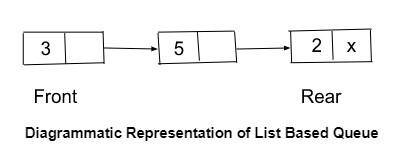
A queue is a linear data structure that inserts and removes queue elements in a specific order. We can implement queues in C by using arrays and linked lists. Both queue implementations have their own advantages and uses. In this tutorial, we will differentiate between array-based queues and linked-list-based queues.
A queue is a series of elements that use the FIFO (first in, first out) principle for element insertion and deletion. Queues in computer science are similar to queues in real life, the first person to enter the queue will be removed first.
The process of removing queue data is called deQueue. The operation of adding data to the queue is called enQueue.
The queue has two points -
After- Elements in the queue are inserted from here.
Front- The element in the queue will be removed from here.
We can implement queues in two ways -
Array-based queue
List-based queue or linked list queue
Queues implemented using arrays are called array-based queues. It uses two pointers: Front and Rear, which represent the deletion point and insertion point in the Queue respectively.
In this implementation, the array size is predefined before data is inserted. This is the simplest way to insert and delete queue data.

In list-based queues or linked-list-based queues, linked lists are used for queue implementation. Each queue node consists of two parts: one part is used to store data, and the other part is the link part or the memory part.
Each queue element is connected to the memory of the next queue element. There are two pointers in a list-based queue -
Previous pointer- Memory representing the last queue element.
Back pointer- The memory representing the first element of the queue.

S.No | is:
号 |
Array-based queue |
Queue based on linked list |
|
|---|---|---|---|---|
1 |
Complexity |
It is easy to implement and perform operations. |
It is not easy to implement. |
|
2 |
Search process |
It helps to search easily and quickly. |
Slow speed and difficult search operation. |
|
3 |
Queue size |
Define the queue size during initialization. |
No need to define the queue size when initializing the queue. |
|
4 |
Insertion and deletion operations |
It is difficult to insert data at the beginning, but easy to insert data at the end of the queue. |
It provides simple data insertion at both ends of the queue. |
|
5 |
Access data |
Random data access. |
It provides sequential access to queue elements. |
|
6 |
Queue size adjustment |
Changing the queue size is difficult. |
It's easy to adjust the queue size. |
|
7 |
Memory usage |
It consumes less memory. |
It consumes more memory. |
|
8 |
advantage |
|
|
|
9 |
shortcoming |
|
|
If your queue has a fixed size and there is no need to change the queue size, you can implement the queue using an array. Array-based queues are also useful when searching is fast and consumes less memory.
Linked list-based queue implementations are useful when the queue size is dynamic and queue elements are inserted and deleted multiple times. Although it consumes more memory, it is suitable for large-scale applications
Using array-based queues and linked-list-based queues depends on requirements. In large-scale applications, array-based queues are unsuccessful and linked-list queues are used instead.
Array-based queues use less memory, but waste a lot of memory because after inserting elements in the backend, there will be some unused memory left before the first element.
The above is the detailed content of Difference between array queue and linked list queue. For more information, please follow other related articles on the PHP Chinese website!
 The difference between static web pages and dynamic web pages
The difference between static web pages and dynamic web pages What is the difference between 4g and 5g mobile phones?
What is the difference between 4g and 5g mobile phones? The difference between k8s and docker
The difference between k8s and docker The difference between JD.com's self-operated flagship store and its official flagship store
The difference between JD.com's self-operated flagship store and its official flagship store what is vb program
what is vb program How to solve website restore error
How to solve website restore error What to do if the computer fakes death
What to do if the computer fakes death what is world wide web
what is world wide web



